To make my growing season preparations more high tech I built a grow light with more than 25000 lumens light output while spending less than US$300. During the build I posted pictures/short notes on Makers, Hackers, Artists and Engineers Google+ community and received a lot of questions concerning LED choice, drivers, build of materials and construction details. This article is intended to answer these question and hopefully generate others – please don’t hesitate to ask!
The goal of this project was to produce a decent grow light for personal indoor gardening – mainly starting vegetables for subsequent transplanting outside some time in May and possibly extending the grow season in the autumn. While trying to determine necessary light output I realized that good numbers are impossible to find. By reading numerous indoor gardener’s forums I learned that people are having good results with light sources ranging from household-type compact fluorescent bulbs to high pressure sodium street lights. After analyzing pros and cons of all available light sources I decided to use high-power white LEDs. Here’s why:
- They are low-voltage devices therefore they are much safer to work with than HID/fluorescent light sources. Low-voltage (<60V) LED drivers are also inexpensive
- They are efficient as grow lights. Photosynthesis in plants occurs differently under different wavelengths of light; the “good” light is known as Photosynthetically active radiation (PAR). White LED emits most of its light in PAR – out of all light sources it produces most “PAR lumens” per unit of electricity used to produce these lumens. In addition, LED outputs all its light from one side therefore a light fixture doesn’t need a reflector.
- They can last long time. LED manufacturers specify 50000 hours at some pretty high emitter temperature (75-85C) – it’s 11.4 years if lights are on 12 hours a day. At the end of 500000 hours a LED maintains 70% of its light output. The main factor here is temperature of the LED – if it is kept lower than specified the LED will last longer (and produce more light, see below).
As I mentioned before, it was difficult to determine the necessary light output of the fixture I was about to build. For this reason, I started to look at available power supplies first. After browsing through offerings on eBay, Aliexpress and electronics components supplier’s sites I sized my supply at 300W – the power is good and the cost is not excessive. The representative supply is Meanwell model S-320-48. The price is ~US$70 for a genuine one and ~US$30 for a clone. Dealing with clones is involving – at the very least, you’ll need to a) inspect a power supply inside (involves non-destructive removal of warranty stickers, requires finesse), b) test for load and ripple ( requires some pretty specific equipment, like 300W dummy loads), c) burn-in for a couple of days under full load (difficult to do safely in residential setting unless you have an empty 2 car garage), and d) undo the deal if you’re unhappy with one of the previous steps. Buying/returning on the Internet takes time; I suggest not buying from China – transit times are too long. I had to return 2 supplies; the third one turned out to be a genuine Meanwell with a cut-off sticker – for the price of a clone.
A 300W power supply can drive 250 – 280W of LEDs. At present, high-power LEDs are available in 2 flavors – single emitter and multi-LED modules. The big advantage of a single emitter is low price per unit. However, they are harder to work with – to build a 270W light out of 3W LEDs you will need 90 emitters each requiring 2 mounting holes, 180 drilled and tapped holes in total. Also, they come soldered on so-called “star” heatsinks with uncertain thermal characteristics – thermal conductivity of tin is 3.5 times lower than aluminum therefore thermal resistance between an emitter and its heatsink highly depends on the thickness of solder layer under the LED which no one seems to even attempt to control. In addition to this some “LED mounters” use lead-based solder which has even lower thermal conductivity – 5 times lower than aluminum. Another big disadvantage of single emitter LEDs is that it is hard to get a genuine one. Most mounted LEDs sold to me as “Cree” or “Bridgelux” were fake – I have about 30-40 pieces of each name bought from different places. What is interesting is that all Luxeons I have (another 50 pieces) are genuine. Lastly, single emitter LEDs are about twice as expensive per watt – 45W Cree CXA011 from the brightest bin costs US$15.23 at Mouser whereas mounted “Generic 3W Epistar” at stevesleds.com sells for $1.85 (prices at the time of writing), and if we start comparing lumens per watt (assuming that we can reliably determine real lumen output from generic emitter) the difference will become even larger.
Now that we know that multi-emitter modules are the way to go let’s take a look at what’s available. Chinese make decent modules (search eBay for ’30W white led bead’ to see these good looking products mounted on hefty aluminum bases measuring ~45mm across). I have used them in my past projects – they work well and they are easy to drive, typical forward voltage at 1A being ~34V. The problems with Chinese products are a) the quality is unknown – you can get decent product or a piece from rejects bin, and b) the real characteristics of the device are unknown. After looking further and comparing watts per dollar, lumens per watt and whatnot, I decided to go with Cree CXA2011 module ( Link to the datasheet ). The main reason to pick up this particular module was ease of mounting. The second reason was price. Lastly, the module is available from established US suppliers in manufacturer’s packaging therefore the probability of getting a fake is low. Picture on the right shows the module bolted to a heatsink by a pair of #4-40 screws. My grow light uses 6 of these. CXA2011 has several color temperatures and light output variations, the full part number of ones that I use is ‘CXA2011-0000-000P00J050F’.
I wanted to keep my LEDs as close to ambient temperature as possible. This means I needed forced-air heatsink. The one on the picture is Rosewill RCX-Z80-AL AMD CPU cooler designed for 70W load. It is available from many places for ~US$7.00. It is many times cheaper than “specially made for LED” heatsinks and it works very well. I learned from the reviews that the included fan is good for two years.
An advantage of having a grow light with fans is that air movement in a grow room is beneficial for the plants and 6 fans produce pretty decent wind – strong but not excessive. The disadvantages of having a fan is a) extra current consumption and extra power supply, b) noise, and c) extra maintenance. However, since convectional cooling is not possible anyway I would need to learn how to deal with them.
After mounting a module using Arctic Silver 5 thermal interface material and running it at 1A (the maxumum allowed by a manufacturer) I measured 1C temperature difference between the case of the module and the heatsink surface right next to it. Anywhere else the heatsink measured 22C which was ambient temperature at the moment. It was probably possible to have 2 LEDs per heatsink and still get good dissipation but at the end I decided to just have one.
Up to this point I did all my tests using bench power supply. I learned that at 1A the forward voltage of the module is close to 48V while the datasheet showed slightly less than 46V. It also means that the power consumption is 48W instead of specified 45. I don’t know how this extra power increases light output so I will continue using datasheet numbers for light. I also know that LED forward voltage increases slightly with temperature therefore I need a LED driver which will go over 48V at 1A. The one I picked is Meanwell LDD-1000H. Picture on the left shows 3 drivers mounted on a protoboard. The driver needs at least extra 3V on the input so I tuned up the power supply output to 55V.
When all major components are specified it is possible to calculate the price. Here is a list:
- Power supply, 48V, 312W, Meanwell S-320-48 or similar. $30 for “similar”
- Cree CXA2011-0000-000P00J050F 45W LED modules, 6x$15.23 = $91.38
- Meanwell LDD-1000H 1A 52Vout max. LED driver. 6x$11.52 = $69.12
- Rosewill RCX-Z80-AL AMD CPU cooler. 6x$6.99 = $41.94
The total for the main ingredients is $232.44. The price for miscellaneous small pieces such as fasteners, aluminum angle, polycarbonate, solder, connectors, etc. is hard to estimate (I just have all this lying around); it is still safe to assume that total is going to be $260 – $280 depending on what you have on hand already.
Couple other notes about pricing. First, it is possible to negotiate prices on eBay. Many sellers provide “Make offer” button which you need to use wisely – do not try to offer $5 for $30 power supply since your offer will likely be declined without further discussion. It is much better to offer $20 initially and then add a little during each round. It is also possible to discuss (and lower) shipping charges.
Second, it is easy to scale down this light – just use smaller number of LEDs. You will need to account for other pieces too – a single combination of LED, driver and heatsink costs ~US$35. In my opinion, the smallest number which makes sense is 3.
The construction of the light is very simple. The most tedious task is drilling/tapping holes in heatsinks and two 22″ 1/4 aluminum angle pieces. After the main structure (pictured on the right) is put together LEDs with wires soldered on are mounted on the heatsinks. After that it is necessary to cover the LEDs with a piece of transparent plastic to protect the lens – I used 0.118″ polycarbonate. The drivers are mounted on the sides of the structure, 3 on each side. LED wires are soldered to the drivers and zip-tied to the angle pieces. Finally, fans are mounted on heatsinks and wired together. They are powered from their own 12V 1A wall wart at the moment; I’m planning to add a step-down converter to power them from the same 48V supply which still has some power to spare.
Next two pictures show construction details. First picture shows LEDs mounted on heatsinks, wire routing and transparent protective LED covers – again, very important pieces! Second picture offers view from the top showing fans as well as LED drivers mounted on the sides.
I don’t own a photometer so I need to estimate light output from numbers in the datasheet. First thing to do is to determine the working temperature of the module. The datasheet states effective thermal resistance junction to case being 0.4C/W, which means that at 48W the die will be ~20C warmer than the case. I am assuming that all energy in the LED is converted to heat, which is very conservative. Early illumination-grade LEDs converted about 10% energy to light, modern ones are close to 20%. For 20% the temperature rise will be 15C. Now, the measured difference between case and heatsink (given earlier) is 1C – let’s just forget about it since it doesn’t make any difference. Another measured temperature is ambient in my small grow room where this light has been deployed for several days – 30C. Adding 20 and 30 together gives 50C – this is the temperature of the LED die during operation.
We can continue going through numbers in the datasheet or we can take a shortcut by looking at the following presentation, which gives output of 3480 lumens per module at 45W and 85C. This means my light puts out 23040 lumens (page 7). Since my emitters run colder I’m getting more light. How much more? If we refer to the datasheet again (page 5) and analyze flux vs temperature relation we will see that at 50C the light output rises by roughly 10%, which means my light outputs more than 25000 lumens – 25344, to be exact. The difference is equal to 0.6 light output of a LED module; it can be seen that heatsink fans pay for themselves – they consume 12W but add (or save) 27W!
The light has been in operation for several days – too early to notice any effect on plants (and I just started my seeds so I don’t even have any above-ground growth at the moment). However, I noticed that it gives just slight temperature rise in my very small grow room and produces nice breeze. In addition, it is easy to build and safe to operate. Needless to say, I’m very pleased with the result.
Oleg.

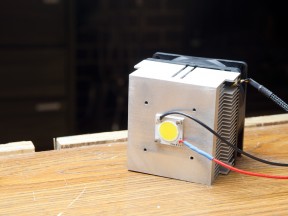
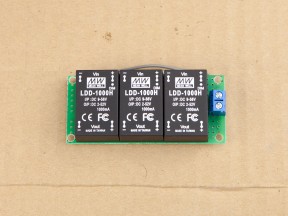
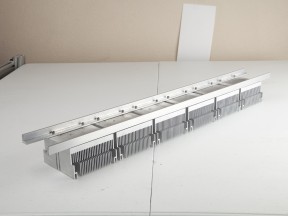
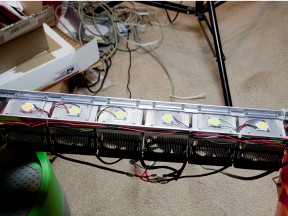
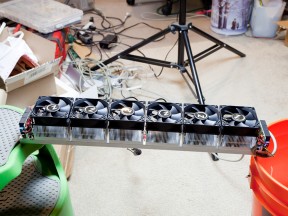
I have been inspired by your grow light!
Here is my plan for a 1000w HPS replacement, possibly providing more PAR lumens.
72,000 PAR lumens, maybe I will use only 6 LEDs, or maybe I’ll just be able to grow more than a HPS light
710 watts including driver losses of 10%
$1000 in parts plus mounting brackets, power cords, etc.
$190 a year at 12h/day
redundant fans on heatsinks!
8x Bridgelux Vero 29 80 watt LEDs at 8,000 lumens each (2 inch die!) $380
I learned that some frequencies/colors of light are absorbed more than others, so you can look at where the peaks are in the datasheet.
These LEDs can run at higher power but it hurts their lifespan and lowers efficiency.
http://www.bridgelux.com/wp-content/uploads/2013/10/DS33-Bridgelux-Vero-29-Datasheet-2013.07.18.pdf
8x Meanwell CEN-100-48 48V 2A AC to DC CC/CV driver $380
It should easily account for changes in forward voltage, which can go up to 44v. 2A should make these LEDs last for 50,000 hours with the right heat sink…
http://www.meanwell.com/search/cen-100/CEN-100-spec.pdf
8x Cooler Master Hyper 212 Plus $240
180W max dissipation heatsink, with copper heatpipe direct contact. The LEDs should run at about 60C max.
http://www.newegg.com/Product/Product.aspx?Item=N82E16835103065
Now I have to figure out how to mount this all together..
Great panel. Thanks for sharing your work.
Can I ask what way your fans are blowing?
Are they blowing air onto the heatsink or pulling the heat away the heatsink?
How could I make something with a dimmer? I only need one light around 100w, what is the best solution? Is it as simple as a cpu heatsink and fan wired to a adapter + the led wired to a driver and both stuck together?
The drivers I used (and many others) allow for PWM dimming so you just need a source of PWM, like an Arduino or similar.
Beautiful job, and well researched. Thanks.
Hi, intriguing write-up, thanks. Have been constructing some driver circuits for LEDs too, and one tricky bit is always the heatsinking. It’s impressive to be able to consider the heat sink and ambient temperature as approximately the same, and that’s a nice calculation showing that the active heatsinking more than compensates for itself with increased LED efficiency. I’ve been experimenting with the 10W LED modules, underdriving them to stick with passive cooling. Amazing tech, these LEDs.
What a great set-up! Thank you for writing this– it is really helping a lot of people.
Pardon the ignorance, but what is the difference between a power supply and a driver? On MouserElectronics they have products listed as “LED Drivers Power Supplies”. I get that the power source is what supplies the juice to your lights, but the driver?
Again, thank you for your assistance!
Hello,
I would like to run one Cree CXA2011, so would i purchase one power supply 48 volts at How many watts ???
you’ll also need a LED driver. For a single LED you can just buy an off-line one.
Hello & many Thanks, I hate to ask but what is off line ?
and as mentioned one led driver.
Have a good 1, Bulldog
What do you think of this product ……
Cree UR3-24 LED – Cree one foot x two foot
2 bulbs with one led driver.
Input 36 watts, CRI : 80 , color 4000 kelvin
Efficacy: 100 LPW at source level.
Tx Bulldog
what are you going to do with it?
They are actually tubes
Good for growing tomatos ?
30W is quite dim. From my experience, for good growth 200W LED light per sq.m is the minimum.
Oleg, Great build. I am new to the led world and would like to tap into your wealth of knowledge. I am trying to plan a build for a terrarium build in a 20 gallon tank (lots of carnivorous plants) and get around 20,000 lumens. I am looking at the Cree cxa2530 in 2700k x2 and 5000k x2 due to higher CRI options and fewer cob’s needed. I have little knowledge of how to correctly wire a unit such as this and can not seem to find a wiring diagram. I am assuming that you used the one power supply to power the six drivers wired in parallel. Do you think it is possible to put two emitters on to one larger heatsink and effectively cool them? Any recommendations on wiring and components would be greatly appreciated. Thank you so much for your time and information.
Drivers are powered in parallel. If you want to drive several LEDs from one driver they (LEDs) must be wired in series. The limiting factor is the forward voltage across the string of LEDs which is the sum of forward voltages of the emitters in the string. The LDD-xxxH drivers have max.output voltage of 52V and need 56V on the input to provide max.current at this output voltage. Also, the Vf depends on temperature of the device and for well-cooled LEDs is higher than the datasheet value, typically given for max.working temperature. For example, a CXA2011 at room temperature drops 49V while the datasheet states 37-42V. I would experiment with a single emitter, measure Vf and then decide whether a second one can be added.
Could you post a picture of the back of your ldd driver board so I could see the connections? It would helpme better understand, I am trying to decide if I can build my own ldd driver board with stripboard but I’m a bit worried about having 4amps @48volts(using cxa2520). Do you havebany thoughts on the safety of the above?
Thanks for your time Oleg!
Read your work feels good. I now make a grow light, now Cree cxa 2011 is out, replaced by Cree cxa 1250ma Meanwell LDD-1000H 2520 2520 high current only up to 1A: do you know whether there is any alternative to the part? Also I would like to ask you when you have used the led picture? I would like to know how do you hook it up. Thank you
CXA2011 are still available, bought a tube the other day. I like them better than the newer ones: easier to drive and mount.
I didn’t understand your other question.
It is interesting you have chosen white light for this project. While it will work, I think a lot of your power is going into the ‘green’ component of ‘white’ where plants aren’t terribly sensitive. PAR covers the entire spectrum from 700nm to 400nm light, but plants only use a few small ‘peaks’ in that spectrum.
Another issue with LEDs is they have a very sharp spectral peak in one wavelength (or 3 wavelengths for white …one each red, green and blue) Plants also respond to a few sharp peaks…740nm, 660nm, 460nm, 440nm, etc. For maximum efficiency, the LEDs need to emit at the plant response peaks.
So bottom line, you could probably make a much more efficient light by choosing various red and blue LEDs at the proper wavelengths. This light would actually appear dimmer to the human eye and may have a lower ‘PAR’ rating, but would actually put much more energy into the spectra plants can use.
Take a look at the spectrum of any white LED to see how much “green” is actually emitted -> http://www.cree.com/~/media/Files/Cree/LED%20Components%20and%20Modules/XLamp/Data%20and%20Binning/XLampCXA2011.pdf (page 5). Also, take a look at PAR to see how “small” the reaks actually are -> http://en.wikipedia.org/wiki/Photosynthetically_active_radiation.
Hello, I would like to know how do you hang your lights? Because it looks like there is no place where you can hang
I hang it with bungee cords hooked to the angle pieces on the sides.
I dont get why u guys r spending so much on these light set ups when u could have gotten something for so much cheaper to do the samething?
Hi there
I have bought a 500 watt LED chip the spec is 70-78 volts @ 6.9 amps, I am wanting to drive the chip at only half power or just below, does anyone have any ideas how I can achieve this, your help would be much appreciated. my contact email is tn21@live.co.uk
Regards
JT
Hello Oleg – Nice work, appreciate you sharing this project. I have been researching a number of solutions for coverage as over the past five years I have been disappointed in the prior Gens of LED’s. It was not until ALED in 2012 released the 350XML that I began to see promise, and presently I am testing a Spectrum King 400.
My brother in law and I are looking over a few designs we have in early stages of development, these will be used for indoor growing, primarily vegetables, fruits, nuts, herbs and berries. We live in a limited photoperiod climate in the Northern Midwest.
From a purely theoretical POV, I am focusing beyond purely “photosynthesis” spectrum for “leafy greens” – the Sun provides 296nm-1300nm and although UV becomes an issue below 365nm for Genetic Damage, there is a fair amount of research showing benefits from 360 to 405nm. For IR up to 800 or so as well. Presenting a slightly broader spectrum is our goal.
I have been growing for well over 3 decades and simply see an opportunity space for indoor, localized food production and would enjoy discussing this with you if you are interested.
Be well and thank you again for your project and sharing.
John @ m2exploration@gmail.com
25 watts per sqft should be a minimum for growing leafy green @ 5000K, for fruiting plants – such as nightshades you will need to add 3000K diodes at a ratio of 3 to 1 @ minimum and increase watts to 35 sqft for better yields and proper uptake.
John,
Do you have a recommendation for a smaller system (100 W) for vegetative growth? something with hyperlinks for LEDs and Drivers would be great.
John
John
do you have specifications for LEDs and LED drivers? Alternatively, could you direct me to a website that might help with a smaller (100W system)?
thans
John
Hello Oleg
Seems you are very knowledgeable I want to make a grow light also why doesn’t anyone use the reels they have on Ebay they are a lot easier to use same 50,000 lm/hrs life? They are 15 feet long I want to make a 5ft x 5ft grid how do I know how much power I am going to need I will probably use 5 reels 3 red and 2 blue and cut the in 5 ft lengths?
Thanks
Mike
hi oleg!
whats your experience by now with this type of light?
you said that your light was too strong for this size of grow room,
have you tried other watt amounts for this size?
can you make a statement about watt per squarefeet and how much is beneficial before it turns unproductive?
thanks a lot for sharing your knowledge and experience!
regards,
Steve